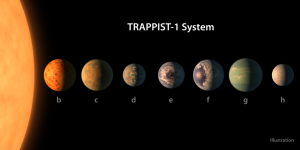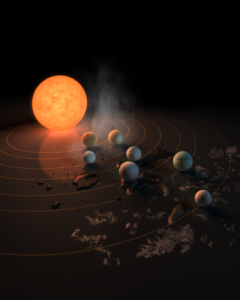Who could have known that the constellation Aquarius, which means the Water Bearer, would have so many planets that could have liquid water around a single star?
TRAPPIST-1 planets, artist concept, Credits: NASA/JPL-Caltech
Last week, NASA announced an astonishing discovery – seven Earth-size planets have been found orbiting around one single star.
All seven planets could potentially have water on their surface under the right atmospheric conditions. What’s more, three of these planets orbit around the star in an area called the habitable zone in which a rocky planet has the highest likelihood of liquid water. All life, that we know of, requires water.
TRAPPIST-1 star artist concept, Credits: NASA/JPL-Caltech
Outside of our solar system, this system now holds the record for having the most habitable-zone planets orbiting a single star. The first system of its kind to be discovered, it’s relatively close to us at about 40 light-years away from Earth in a constellation called Aquarius.
The system, TRAPPIST-1, is named for a telescope in Chile called The Transiting Planets and Planetesimals Small Telescope (TRAPPIST). Last May, researchers announced their finding of three planets in this system using the telescope. Spitzer, with help from multiple ground-based telescopes, confirmed two of the planets found by TRAPPIST and found five more.
The astonishing discovery came from NASA’s Spitzer Space Telescope. Launched in 2003, Spitzer follows behind Earth in an orbit that trails the planet around the sun. Data received from Spitzer allowed the team to measure sizes of the seven planets and estimate the masses of all except the farthest exoplanet. All seven planets are likely to be rocky.
Through future observations, we could find out if the planets are rich in water and if their surfaces could have liquid water. More observations are needed to estimate the mass of the seventh planet which scientists think could be an icy and “snowball-like” world.
The star that the exoplanets orbit is much cooler than our sun, meaning planets could orbit it close by and still have liquid water. It’s called an ultra-cool dwarf star.
Not only are all of the planets in this system close to each other, but they are much closer to the star. Just how close? All of them are closer to their star than Mercury is to our sun. If you stood on one of them, you might be able to see geologic features or clouds of the neighboring planets.
As the same side of the planets could be facing the star at all times, there could be very different weather patterns on these worlds than those on Earth.
On February 22nd, the findings were published in Nature.
Two other space-based telescopes have observed the TRAPPIST-1 system, Hubble Space Telescope and Kepler space telescope. Both of these telescopes and Spitzer will be used to aid in the planning of future studies that NASA’s new telescope, James Webb Space Telescope (JWST), will carry out after its launch into space in 2018.
JWST will be able to sense chemical fingerprints of water, methane, oxygen, ozone and other components of a planet’s atmosphere. Furthermore, the new telescope will study the temperatures and surface pressures of these planets which are essential in evaluating their habitability.
Check out a video about the discovery: https://youtu.be/bnKFaAS30X8
Where is Spitzer Space Telescope now? Check it out – http://www.spitzer.caltech.edu/mission/where_is_spitzer?previous=310&next=36
Learn more about Spitzer Space Telescope: https://www.nasa.gov/mission_pages/spitzer/main/index.html
Learn about James Webb Space Telescope: https://www.nasa.gov/mission_pages/webb/main/index.html



